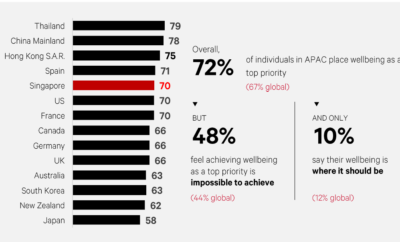
The Gen XY Lifestyle
lululemon survey shows higher wellbeing scores globally in 2022
This is the second annual lululemon Global Wellbeing Report with a key highlight showing that people are enjoying better wellbeing driven by an increased focus on mental health and better coping strategies.
lululemon (lululemon athletica inc. ) has released its second annual Global Wellbeing Report. This is a 10-market study with 10,000 respondents and serves to benchmark the state of wellbeing through a Global Wellbeing Index while also exploring drivers and barriers to being well.
The Global Wellbeing Index is based on how people in markets around the world rate the way they feel across the physical, mental, and social dimensions of wellbeing. Factors impacting wellbeing include: being in good physical health, feeling confident in oneself, managing stress effectively, having enough energy to accomplish daily tasks, feeling in tune with one’s emotions, having a good work/school/home life balance, and getting enough sleep.
A highlight this year is the Index rising to 66 percent, one percent more than 2021. According to lululemon, this increase was due to “… gains in mental health as people have developed better coping strategies throughout the pandemic”.
As we continue to navigate these challenging times, our second Global Wellbeing Survey shows that people are using important coping mechanisms to improve their mental health, yet are yearning for more connection.
Calvin McDonald, Chief Executive Officer, lululemon athletica inc.
Key findings of the The Global Wellbeing Index include:
The higher wellbeing score is driven by an increased focus on mental health and better coping strategies.
- Mental and social wellbeing has improved since 2021.
- Compared to 2021, mental health dynamics have become more important and make up the majority of the most important drivers of wellbeing.
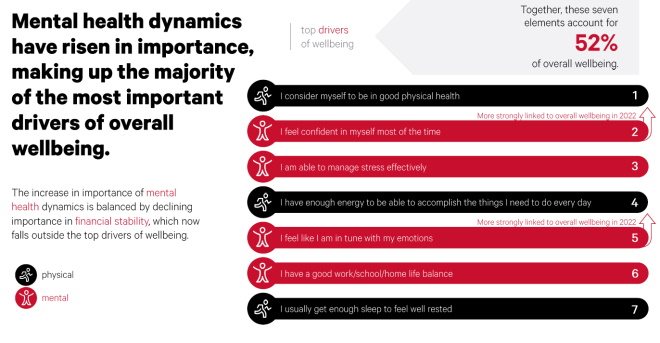
- Respondents reported using a wider range of coping strategies and goal setting with top strategies including getting enough sleep (44 percent), listening to music (43 percent) and connecting with people they care about (40 percent)
- These 4 coping strategies show the highest increases vs. 2021:
- Spending time outdoors (38 percent; up 10 percent vs. 2021)
- Physical activity (up 39 percent; up 9 percent vs. 2021)
- Connecting with people (40 percent; up 8 percent vs 2021)
- Taking breaks to relax throughout the day (30 percent; up 8 percent vs.2021).
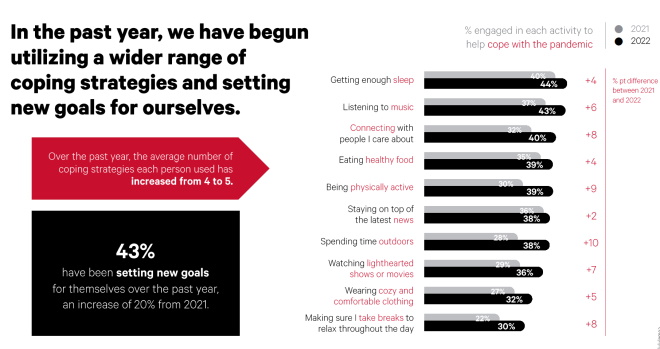
Social media mindfulness continues to impact wellbeing
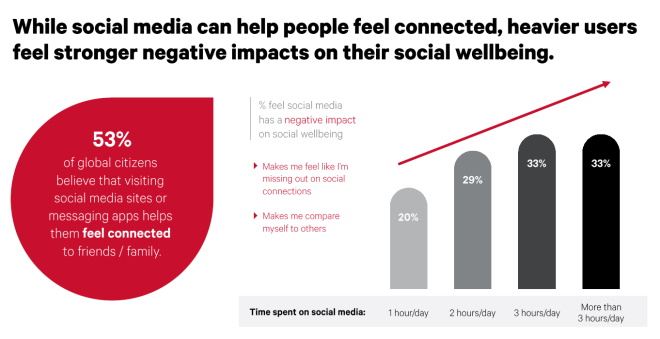
- Wellbeing is strongest amongst respondents that spent 1 hour on social media daily.
- More than half (53 percent) of respondents say that social media helps them to feel connected.
- Heavier social media users (more than 1 hour a day) report stronger negative impacts on their social wellbeing, including feeling like they are missing out on social connections and comparing themselves to others.
- The negative impacts of social media are felt more acutely by Gen Z who spend the most time on social media, averaging 3 hours per day.
- Interestingly, 33 percent of respondents say mindful media consumption has helped them feel less lonely

Employees returning to the workplace report higher wellbeing and are expecting employers to implement lasting changes.
- In the Survey, wellbeing is directly linked with a return to activities. Wellbeing is higher among those who have returned or expect to return to the workplace full-time vs. those who return part-time, or will not return to the workplace at all.

- Many employees who had work-from-home arrangements during the pandemic suffered employment stressors such as:
- Decline in work-life balance (43 percent)
- Increased workload (43 percent)
- Less physically active (33 percent)
- Missed the social aspect of working directly with others (26 percent)
- Less productive at work (17 percent)
- While returning to the workplace benefits wellbeing, employees are equally worried about COVID-19 exposure (53 percent) and having less personal time (52 percent). Parents with children under 13 have pressing concerns about childcare (33 percent).
- Employees have higher expectations of their employers and want long-term changes implemented. Almost half of employees (44 percent) are looking for more flexibility in working hours and location beyond the current pandemic environment, followed closely by increased mental and physical health support (40 percent).
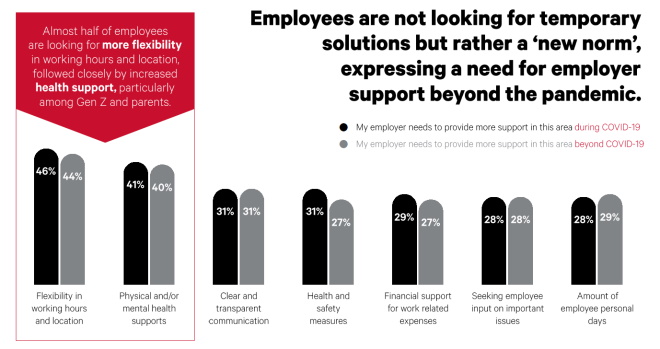
Community plays a vital role in strong wellbeing.
- Those who do find a sense of community and giving back to one’s community important are more likely to indicate stronger levels of wellbeing.
- Half of global citizens (52 percent) recognize the importance of community and agree that it is important to feel a sense of belonging to a community – one of the top drivers of social wellbeing.
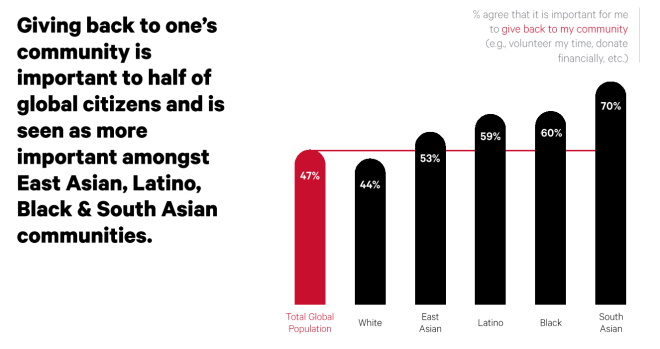
- Those who do not recognize the potential benefits of community are seeing negative impacts on their wellbeing, with only 15 percent indicating strong overall wellbeing vs. global average of 29 percent.
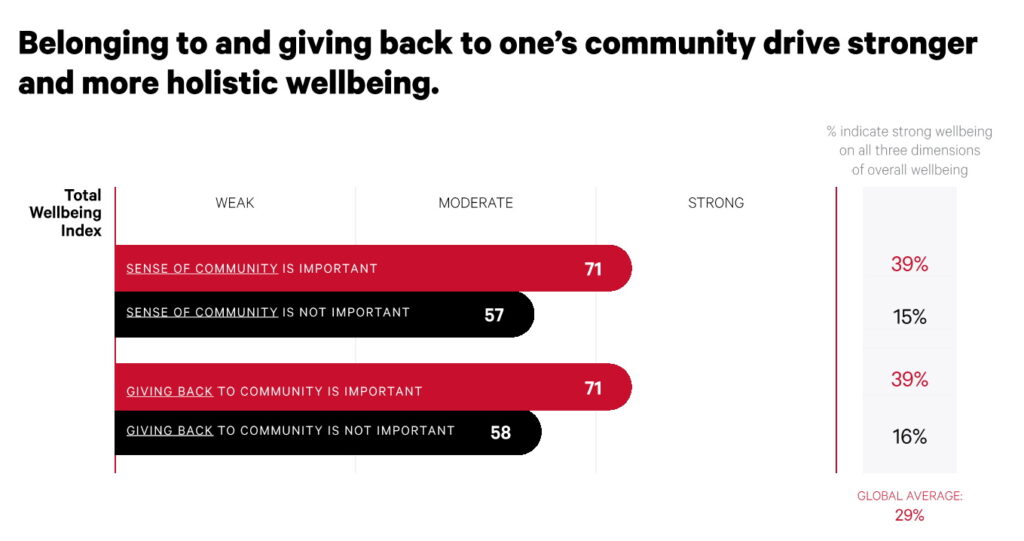
All data and images are credit to lululemon and the lululemon Global Wellbeing Report.

